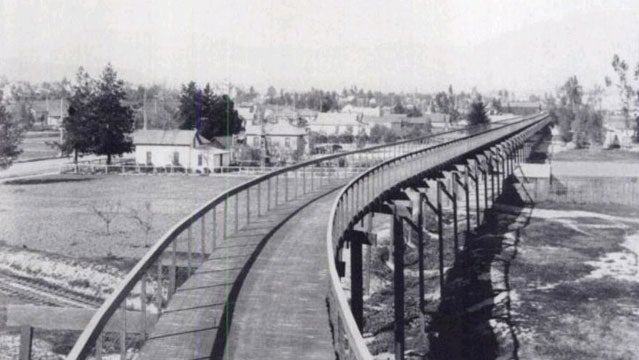The automobile was very disruptive technology. Lest we forget this fact, consider the . In the late 1890s, Pasadena, Calif., an enterprising man named (who would later become Pasadena mayor) Horace Dobbins hatched a plan to capitalize on the love affair Angelenos had formed with the bicycle. He proposed that an elevated, dedicated wooden path be constructed to link the cities of Pasadena and Los Angeles.
Dobbins managed to get an initial, short section of the path built, but then a major cultural shift took place: people started buying cars. “When the cycle-way was being built, the day of the bike was ending. It’s important to understand that Dobbins was not a bicycle visionary; he wanted to build a paid freeway that provided the easiest means of getting to downtown Los Angeles,” says Dan Koeppel, a LA-based writer who is working on both a documentary film and book about L.A. transportation and, specifically, the cycle-way.
“If you look at the idea of the car as an individual means of transportation, well, the bike was the vehicle of that myth at that time,” says Koeppel. “It was the fastest way to get from point A to point B, and Dobbins wanted to give people the easiest way to get to downtown Los Angeles from Pasadena.” (This was not a gift to the community: the cycle-way was envisioned as a tollway, with riders paying around 15 cents for access between the two cities.) Unfortunately for Dobbins, before the cycle-way could be completed, the automobile had taken that role.
Then, over the next century of development and population growth, the car lost that lead. “At most times of the day, I can get from Pasadena to L.A. faster by bike and bus than by car,” says Koeppel.
The concept of a cycle-way has been resurrected in recent years. The city of Copenhagen is building a network of more than 25 bike “superhighways” that link the suburbs with the city. London and many other European cities are also building or have already built dedicated bike roads. Among the amenities these bike-dedicated paths offer are tire pumps and traffic lights timed to keep the stream of commuters pedaling.
Most U.S. cities have at least a small network of bike lanes, and many have impressive and growing bike infrastructures. Whither car city, Los Angeles? Will it ever see the cycle-way resurrected? Koeppel doubts it.
“The infrastructure of automobiles is in L.A.’s blood in way that it is not in any other city,” he says. “The rules the city has made, to get any transportation project passed, is so stacked toward cars. It’s incredibly difficult to get bike lanes funded.”
That didn’t stop Dennis Crowley, a bike racer and enthusiast who worked on Pasadena’s first Bicycle Master Plan and began pushing for the creation of an Arroyo Seco Bikeway in 1996. The vision was for a dedicated cycle-way along roughly the same natural route – the Arroyo Seco – that Dobbins’ path followed. The plan was for a toll to be reinstated as well, which would help pay for the project. never got off the ground, but Crowley was fighting hard for it until he passed away, suddenly, in 2008.
Koeppel says bike commuters in the L.A. metro area have gained some victories in the past five years. But those gains have been measured, at best.
As population grows and cities continue to become denser, car commuting is only going to become a bigger headache. Even car-loving L.A. might eventually dedicate more of its streets to pedal power.
Horace Dobbins dreamed up the cycle-way because he was motivated by growing Pasadena’s economy and profiting from the bicycle craze, rather than some sort of biking utopia. Still, he now serves as an “accidental visionary” says Koeppel. “The fact that people have become taken by this idea of the cycle-way and some pictures of the portion that was built shows that there is something magical about. It symbolizes a gentler industrial America.”
(Hat tip to for bringing the Great California Cycle-Way to my attention.)


